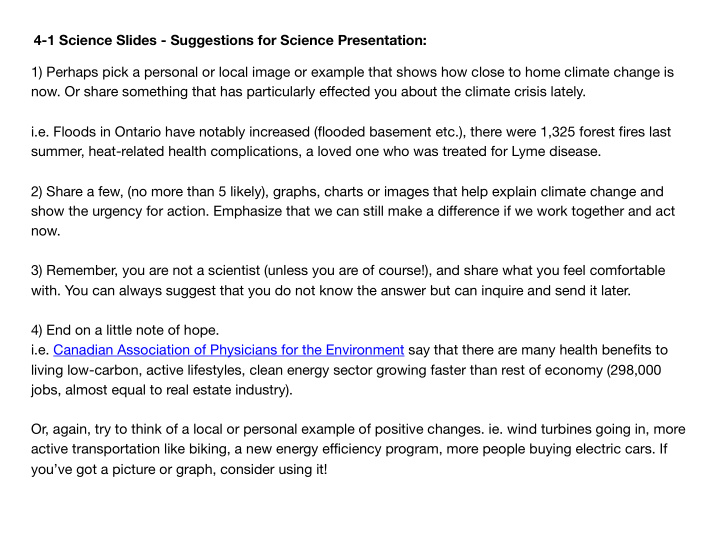



4-1 Science Slides - Suggestions for Science Presentation: 1) Perhaps pick a personal or local image or example that shows how close to home climate change is now. Or share something that has particularly effected you about the climate crisis lately. i.e. Floods in Ontario have notably increased (flooded basement etc.), there were 1,325 forest fires last summer, heat-related health complications, a loved one who was treated for Lyme disease. 2) Share a few, (no more than 5 likely), graphs, charts or images that help explain climate change and show the urgency for action. Emphasize that we can still make a difference if we work together and act now. 3) Remember, you are not a scientist (unless you are of course!), and share what you feel comfortable with. You can always suggest that you do not know the answer but can inquire and send it later. 4) End on a little note of hope. i.e. Canadian Association of Physicians for the Environment say that there are many health benefits to living low-carbon, active lifestyles, clean energy sector growing faster than rest of economy (298,000 jobs, almost equal to real estate industry). Or, again, try to think of a local or personal example of positive changes. ie. wind turbines going in, more active transportation like biking, a new energy efficiency program, more people buying electric cars. If you’ve got a picture or graph, consider using it!
Sample Script: How many of you understand the urgency for action on the climate crisis? I’m going to attempt to give a short synopsis here, about climate science and the crisis it poses. Image 1: Over the last million years or so, the Earth had maintained a happy balance of oxygen and carbon dioxide in its atmosphere. About 220 years ago though, when we started burning fossil fuels for our vehicles and homes, making things like concrete and deforesting, we created an imbalance. This rapid and continued increase of CO2 and other emissions in the Earth’s atmosphere, is largely human-driven. Image 2: This build-up of CO2 in the atmosphere traps more heat and causes global warming. If warming continues to escalate, the world will be a very different place, with many uninhabitable areas due to sea level rise, desertification and extreme heat. If we act now, though, severe health impacts, water and food shortages will effect many millions less people. Image 3: In Canada, temperatures are projected to increase at twice the global rate with warming of 6.5°C possible by the end of the century. Again, if we bend down the curve of emissions quickly, temperatures will not be as high as they might otherwise become. Try to also use local data if you can. climateatlas.ca may help. For example, the number of days above 30 Celsius in Toronto could almost double by 2050 and increase heat-related health threats. According to climateatlas.ca, if we continue with a high carbon output, we could experience a mean of 55 30+°C days/ year between 2051-2080, compared to 39 with a more moderate carbon scenario. An even lower carbon scenario would mean less extreme heat days. Image 4: This graph from https://climateactiontracker.org/countries/canada/ shows that our global commitments are currently not strong enough to prevent catastrophic warming. If you go to their site and look up Canada, our current efforts and commitments are rated as Insufficient, a jump up from Highly Insufficient over the past month or so! Federal actions are still not currently in line with keeping global warming below 2°C, let alone 1.5°C. At the same time, the recent IPCC report and others show that emissions must decrease dramatically before 2030 and reach net-zero soon after that, in order to prevent some of the worst effects of the climate crisis. Emissions basically have to come down as quickly as possible (and methods to draw carbon out of the atmosphere increase). The good news is that we still have time to make a difference if we work together, act collectively and demand an emergency level response from government!
Fossil Fuel Use Starts Neanderthals Came Homo Sapiens Start Neanderthals Left Image 1 - Keeling Curves
Image 2 - Impacts of Climate Change - What holding to 1.5°C can Prevent WWF
From Chapter 4 Figure 4.8. CANADA’S CHANGING CLIMATE REPORT – EXECUTIVE SUMMARY - Government of Canada Image 3 - National Impacts of Lower & Higher Carbon Scenarios Note: RCP stand for Representative Concentration Pathways. RCP 2.6 refers to scenarios that lead to very low greenhouse gas concentration levels. RCP 8.5 represents scenarios with increasing GHG output over time.
Image 4 - The Need for More Action
Recommend
More recommend